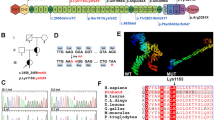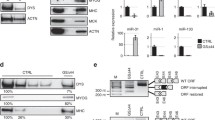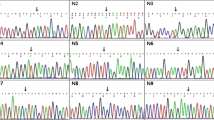Summary
We have identified 7 patients with Becker muscular dystrophy (BMD) in whom analysis of dystrophin by immunoblotting shows a full-sized molecule produced at reduced abundance compared with controls. They have no detectable deletion in their dystrophin cDNA. One patient presented atypically with unusually severe cramps as his only symptom for 25 years. These patients were investigated using the polymerase chain reaction (PCR) with 3 sets of primers within the promoter region of the dystrophin gene, followed by dot blot and restriction analysis. In the patient with the atypical history, one of the expected fragments on PCR failed to amplify. A large deletion was excluded by the finding of normally sized fragments on amplification with the other primer sets. The mutation was localised to the 3′ end of the forward primer binding site by dot blot and restriction analysis. This result supports the hypothesis that, in patients with a full-sized dystrophin molecule produced at reduced abundance, the phenotype may result from a mutation in the promoter region of the dystrophin gene. The atypical history of the patient in whom this was detected adds to the variety of phenotypes now known to exist as BMD.
Similar content being viewed by others
References
Aids to the examination of the peripheral nervous system. Guarantors of Brain (eds) (1986) Baillière Tindall, London.
Becker PE, Keiner F (1955) Eine neue X-chromosomale Muskeldystrophie. Arch Psychiatr Nervenkrankh 193:427–448.
Beggs AH, Koenig M, Boyce FM, Kunkel LM (1990) Detection of 98% of DMD/BMD gene deletions by polymerase chain reaction. Hum Genet 86:45–48.
Boyce FM, Beggs AH, Feener C, Kunkel LM (1991) Dystrophin is transcribed in brain from a distant upstream promoter. Proc Natl Acad Sci 88:1276–1280.
Bushby KMD (1990) A clinical survey of Becker muscular dystrophy in the Northern Region of England. University of Newcastle upon Tyne, MSc thesis.
Bushby KMD, Thambyayah M, Gardner-Medwin D (1991) Prevalence and incidence of Becker muscular dystrophy. Lancet 337:1022–1024.
Chamberlain JS, Gibbs RA, Ranier JE, Nguyen PN, Caskey CT (1988) Deletion screening of the Duchenne muscular dystrophy locus via multiplex DNA amplification. Nucleic Acids Res 16:11141–11156.
Chelly J, Hamard G, Koulakoff A, Kaplan J-C, Kahn A, Berwald-Retter Y (1990) Dystrophin gene transcribed from different promoters in neuronal and glial cells. Nature 344:64–65.
Cornelio F, Dworzak F, Morendi L, Fedrizzi E, Balestini MR. Sandorini L (1982) Functional evaluation of Duchenne muscular dystrophy: proposal for a protocol. Ital J Neurol Sci 3:323–330.
Emery AEH, Skinner R (1976) Clinical studies in benign (Becker type) X-linked muscular dystrophy. Clin Genet 10:189–201.
Fischbeck KH (1991) Mild myopathic syndromes. In: Angelini C, Daniel GA, Rontanani D (eds) Muscular dystrophy research: from molecular diagnosis towards therapy. Proceedings of MDR 90. Excerpta Medica, Amsterdam, pp 61–65.
Gospe SM, Lozaro RP, Lava NS, Grootschollten BS, Scott MD, Fischbeck KH (1989) Familial X-linked myalgia and cramps: a non-progressive myopathy associated with a deletion in the dystrophin gene. Neurology 39:1277–1280.
Hodgson S, Hart K, Abbs S, Heckmatt J, Rodillo E, Bobrow M, Dubowitz V (1989) Correlation of clinical and deletion data in Duchenne and Becker muscular dystrophy. J Med Genet 26:682–693.
Hoffman EP, Fischbeck KH, Brown RH Jr, Johnson M, Medori R, Loike JD, Harris JB, Waterston R, Brooke M, Specht L, Kupsky W, Chamberlain J, Caskey T, Shapiro F, Kunkel LM (1988) Characterisation of dystrophin in muscle biopsy specimens from patients with Duchenne's or Becker's muscular dystrophy. N Engl J Med 318:1363–1368.
Hoffman EP, Kunkel LP, Angelini C, Clarke A, Johnson M, Harris JB (1989) Improved diagnosis of Becker muscular dystrophy by dystrophin testing. Neurology 39:1001–1017.
Hu X, Ray PN, Murphy EG, Thompson MW, Worton RG (1990) Duplicational mutation at the Duchenne muscular dystrophy locus: its frequency, distribution, origin and phenotype genotype correlation. Am J Hum Genet 46:682–695.
Keen J, Lester D, Inglehearn C, Curtis A, Bhattacharya SS (1991) Rapid detection of single base pair mismatches as heteroduplexes on hydrolink gels. Trends Genet 7:5.
Klamut HJ, Zubrzycka-Gaarn EE, Bulman DE, Malhotra SB, Bodrug SE, Worton RG, Ray PN (1989) Myogenic regulation of dystrophin gene expression. Br Med Bull 45:681–702.
Klamut HJ, Gangopadhyay SB, Worton RG, Ray PN (1990) Molecular and functional analysis of the muscle-specific promoter region of the Duchenne muscular dystrophy gene. Mol Cell Biol 10:193–205.
Koenig M, Hoffman EP, Bertelson CJ, Monaco AP, Fenner C, Kunkel LM (1987) Complete cloning of the Duchenne muscular dystrophy (DMD) cDNA and preliminary genomic organisation of the DMD gene in normal and affected individuals. Cell 50:509–517.
Monaco AP, Bertelson CJ, Liechti-Gallati S, Moser H, Kunkel LM (1988) An explanation for the phenotypic differences between patients bearing partial deletions of the DMD locus. Genomics 2:90–95.
Nicholson LVB, Davison K, Falkous G, Harwood C, O'Donnell E, Slater CR, Harris JB (1989a) Dystrophin in skeletal muscle. I. Western blot analysis using a monoclonal antibody. J Neurol Sci 94:125–136.
Nicholson LVB, Davison K, Johnson MA, Slater CR, Young C, Bhattacharya S, Gardner-Medwin D, Harris JB (1989b) Dystrophin in skeletal muscle. II. Immunoreactivity in patients with Xp21 muscular dystrophy. J Neurol Sci 94:137–146.
Nicholson LVB, Johnson MA, Gardner-Medwin D, Bhattacharya S, Harris JB (1990) Heterogeneity of dystrophin expression in patients with Duchenne and Becker muscular dystrophy. Acta Neuropathol (Berl) 80:239–250.
Nicholson LVB, Johnson MA, Davison K, Barren M, Gardner-Medwin D, Bhattacharya S, Harris JB (1991) Patterns of dystrophin labelling in muscle from patients with Duchenne and Becker muscular dystrophy. In: Angelini C, Daniel GA, Rontanani D (eds) Muscular dystrophy research: from molecular diagnosis towards therapy. Proceedings of MDR 90. Excerpta Medica, Amsterdam, pp 240–241.
Norman AM, Thomas NST, Kingston HM, Harper PS (1990) Becker muscular dystrophy: correlation of deletion type with clinical severity. J Med Genet 27:236–239.
Weatherall DJ, Clegg JB, Higgs PR, Wood WG (1989) The hemoglobinopathies. In: Scriver C (ed) The metabolic basis of inherited diseases. 6th edn. McGraw-Hill, New York, 2281–2329.
Author information
Authors and Affiliations
Rights and permissions
About this article
Cite this article
Bushby, K.M.D., Cleghorn, N.J., Curtis, A. et al. Identification of a mutation in the promoter region of the dystrophin gene in a patient with atypical Becker muscular dystrophy. Hum Genet 88, 195–199 (1991). https://doi.org/10.1007/BF00206071
Received:
Revised:
Issue Date:
DOI: https://doi.org/10.1007/BF00206071




